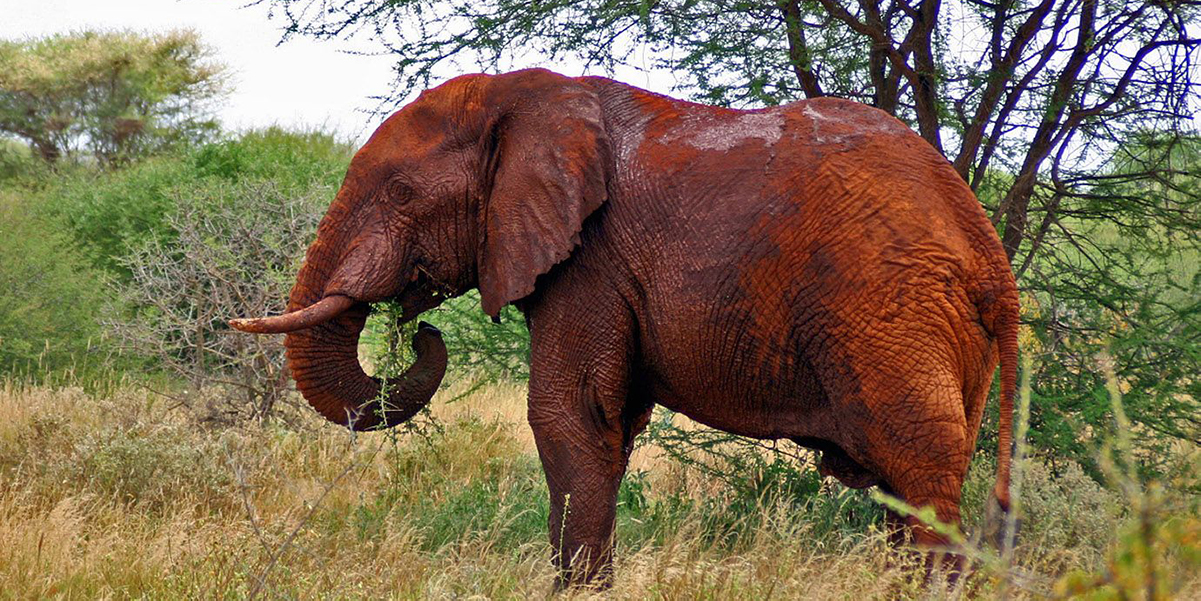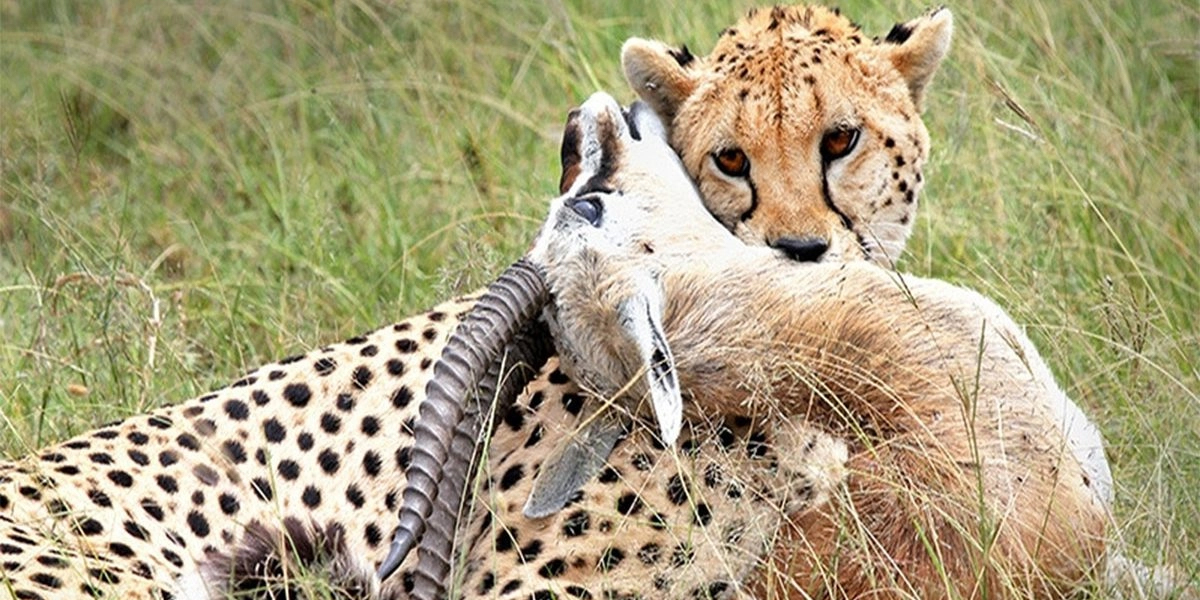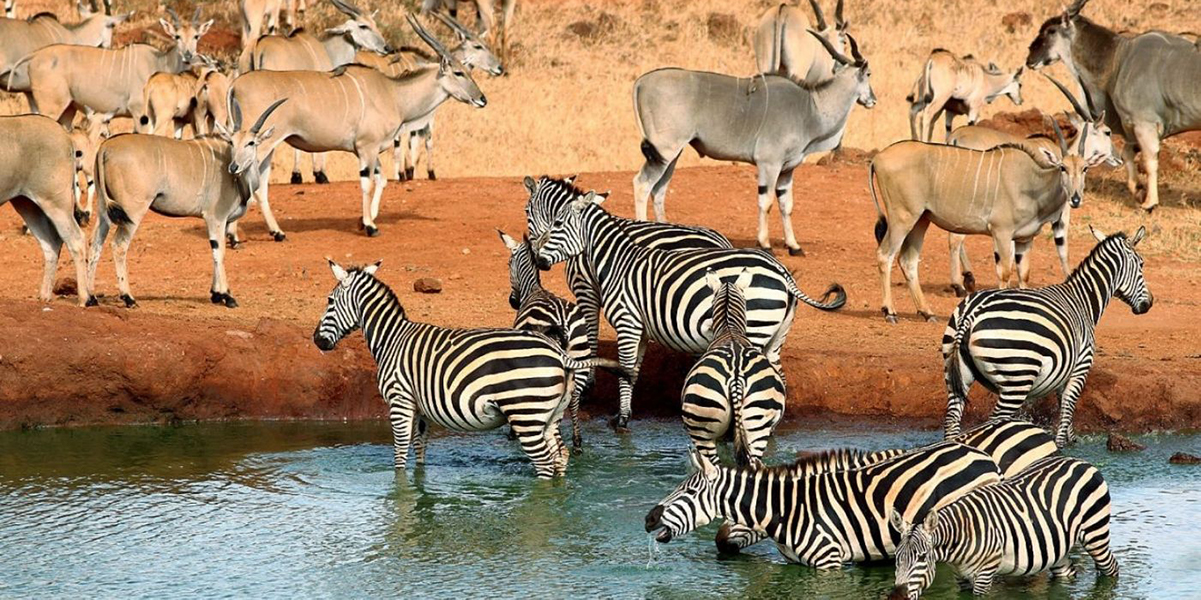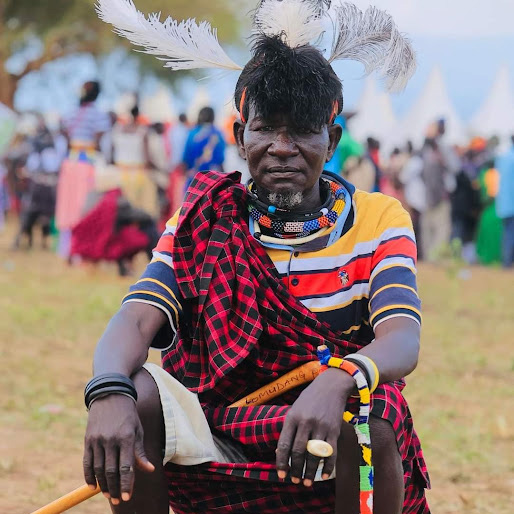Home » Destinations » Tsavo East National Park – Red Elephants, Galana River & More
A cloud of dust rises on the horizon—then shapes appear in it. First tusks, then trunks. A herd of elephants, their skin stained crimson by the red earth, moves slowly across the dry riverbed. A calf stumbles after its mother, kicking up more dust. The wind shifts. Silence returns.
This is Tsavo East National Park—raw, vast, untamed. Where space matters, and wildlife doesn’t have to try hard to impress you.
It’s not curated. It’s not condensed. It’s Africa with the volume turned all the way up.
Because it’s where elephants walk in red, lions hide in plain sight, and landscapes stretch so far they seem to fall off the earth. It’s less about ticking animals off a list and more about feeling small, silent, and completely awake.
Tsavo East is one of Africa’s largest national parks, home to big herds, big predators, and some of the wildest terrain in Kenya. Fewer crowds mean more space—space for you, space for animals, space for real safari silence.

Tsavo East doesn’t come at you fast. It waits for you to adjust your pace.
Wildlife in Tsavo East
The park holds a huge variety of wildlife, often seen in large numbers across its vast plains.
| Species | Where You’ll Spot Them |
| Elephants | All over, especially near Galana River |
| Lions (Tsavo’s infamous man-eaters) | Common but often camouflaged |
| Leopards & Cheetahs | Elusive—best seen near rocky outcrops |
| Buffaloes & Zebras | Found in herds across the open grasslands |
| Giraffes & Waterbucks | Near rivers and seasonal swamps |
| Hirola, Kudu, Oryx | More common in remote northern sections |
| Birdlife | Over 500 species—hornbills, starlings, martial eagles, bustards |
The park is known for its large elephant herds and iconic “man-eating lions” legend—dating back to the 1890s when two lions disrupted railway construction. Their stuffed remains now live in Chicago’s Field Museum, but their descendants still rule Tsavo’s tall grass.
No results found.

Game Drives
Drive through open savannahs with few obstructions. Wildlife often appears far before you arrive—elephant silhouettes, running oryx, grazing impala. The space makes you a better observer.
Visit Lugard Falls & Galana River
The Galana River carves through granite to create a series of rapids and plunge pools. You can walk the rocks near the falls—hear the rush, feel the spray, and see crocs sunning themselves on the banks.
Mudanda Rock
This 1.6 km-long granite outcrop rises like a ship from the plains. Climb to the top for panoramic views of the surrounding landscape and watering holes below where elephants often gather.
Yatta Plateau Viewing
You won’t hike it (it’s massive), but just standing in front of the world’s longest lava flow is enough. At 290 km long, it’s a reminder that nature doesn’t care for limits.
June to October and January to February: Dry seasons are best for game viewing. Animals gather at permanent water sources like Galana River and Aruba Dam.
March to May, November to early December: Wet, green, dramatic. Fewer tourists, more birds, and clearer air—but some roads may be muddy or impassable.
Tip: Dry months offer better photography light and easier animal spotting across the flat terrain.
Tsavo East lies in southeastern Kenya, stretching from Voi town all the way toward the Galana River.
By Road:
From Nairobi: ~5 hours (326 km) via Mombasa Road to Voi or Mtito Andei Gate
From Mombasa: ~3–4 hours (160–200 km) to Bachuma or Sala Gate
By Air:
Multiple airstrips within the park (Voi, Aruba, Satao). Fly-in safaris are available from Nairobi or the coast.
By Train:
SGR (Standard Gauge Railway) connects Nairobi and Mombasa. Disembark at Voi Station and drive into the park within 30 minutes.

You’ll find fewer crowds but great options—from classic safari charm to exclusive hideaways.
| Type | Where | What to Expect |
| Budget | Voi Safari Lodge, Ndololo Camp | Park-based, affordable, with views of watering holes |
| Mid-range | Ashnil Aruba Lodge, Satao Camp | Tented comfort, great food, close to rivers |
| Luxury | Galdessa Camp, Satao Elerai (bordering Amboseli) | Eco-luxury, river views, and wildlife at your doorstep |
Most camps have their own waterholes or river access, meaning you may not even need to leave for the show to begin.
Entry Fees (2025)
Non-residents: $60 (adult) | $35 (child)
Residents/Citizens: KES 500 (adult) | KES 250 (child)
Vehicle Entry: Based on size and registration—check KWS website
4×4 is recommended, especially during or after rain.
Binoculars are a must—animals often appear in the distance.
Fuel up before entering—there are no fuel stations inside.
Stay 2–3 nights to explore different sections. The park is vast.
Ask your guide about the history of the lions—it’s haunting and fascinating.
Tsavo East doesn’t perform for the camera. It doesn’t guarantee sightings or soft lighting. But it gives you space—real, uninterrupted space to feel the wild without fences, without schedules, without needing to be anywhere else.
So—are you ready to follow the red road to where the elephants walk free?
Give Us a call or arrange a meeting with one of our Travel Consultants to discuss more your Kenya Safari Adventure



Send an Email
Rm 2B Ground Floor, Tetu Appartments, Milimani Lane, Nairobi.
© 2025 Serengeti Mara Experts LLC All Rights Reserved